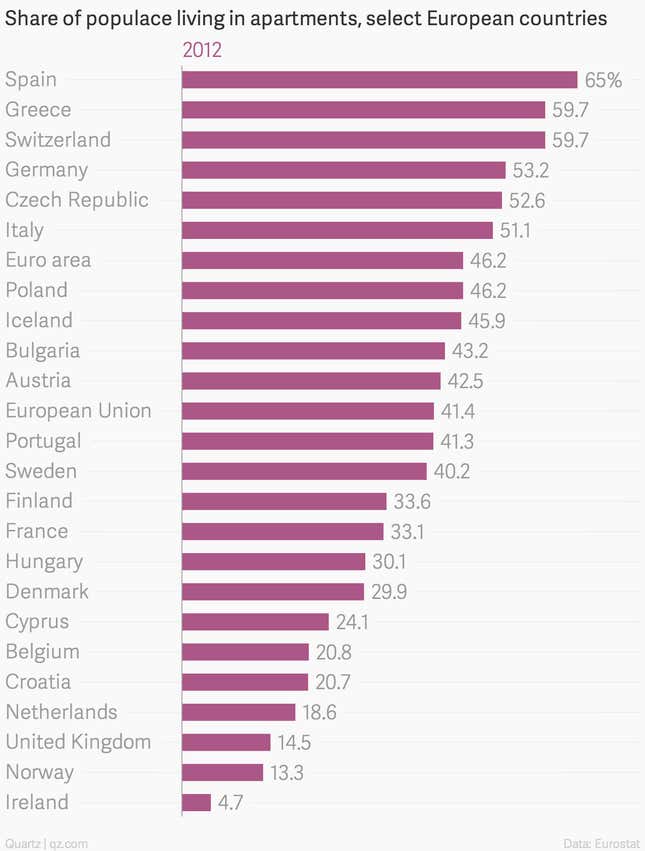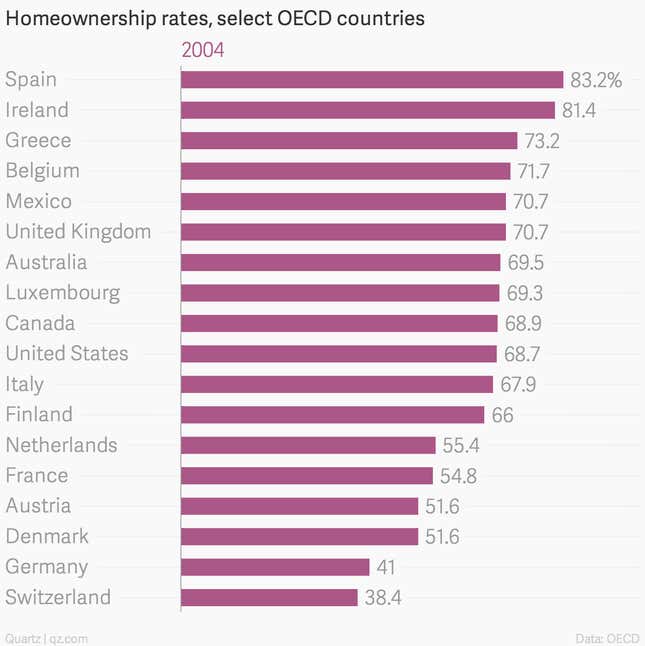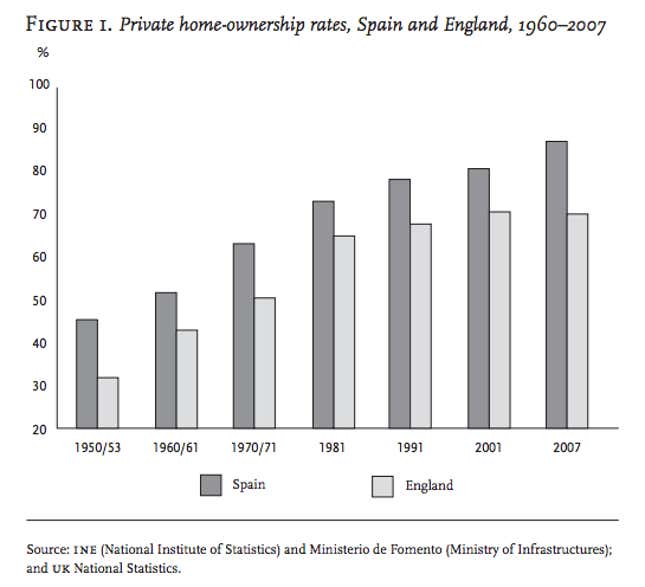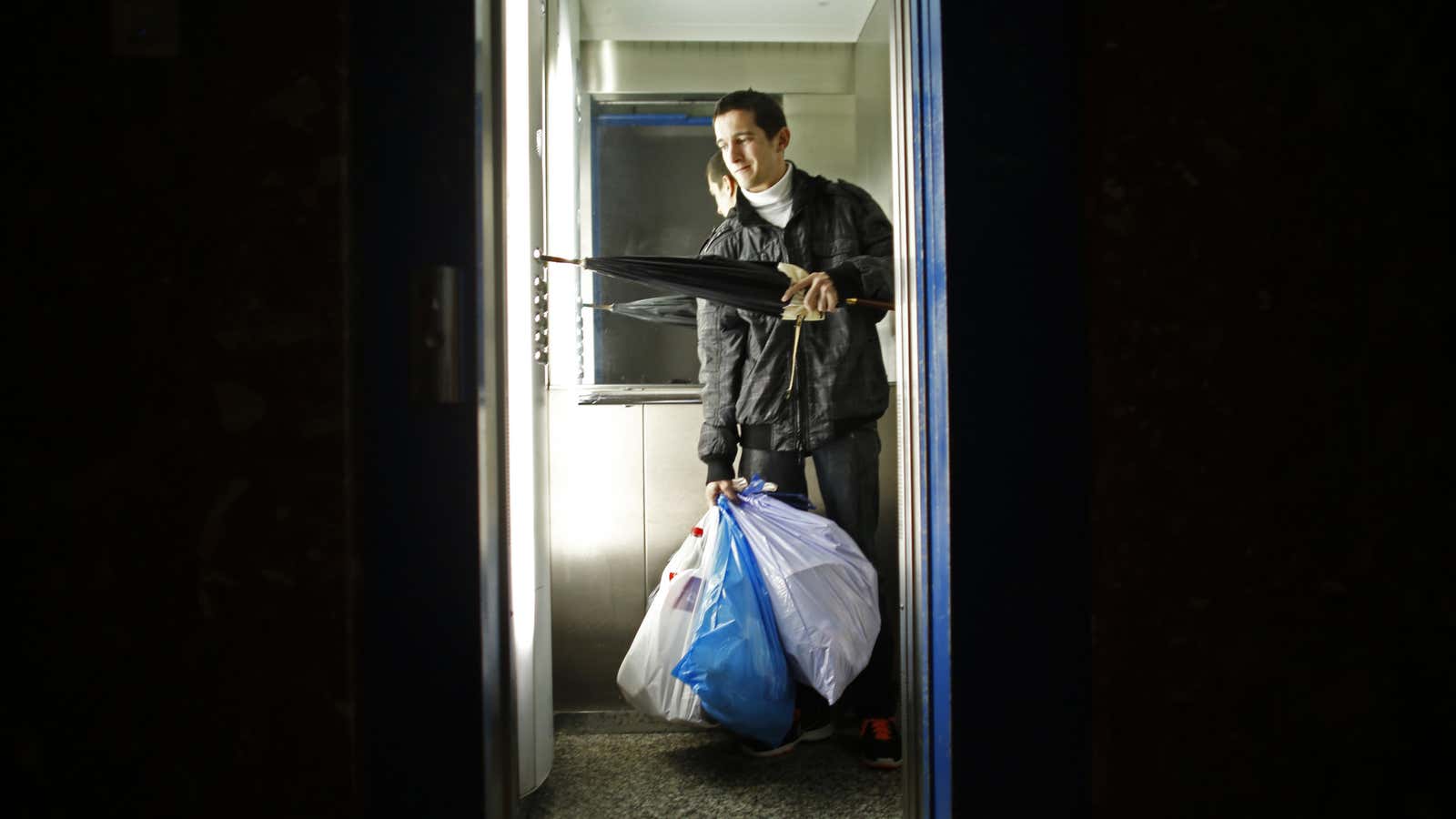When you think about Spain, the first thing that pops into mind is undoubtedly one word: Elevators.
No? Well, maybe it should be.
Compared to other countries, Spain’s elevator supply looks remarkably, well, elevated.

At face value, there’s a pretty simple reason why. Spaniards are some of the world’s pre-eminent apartment-dwellers. In 2012, roughly 65% of the population lived in apartment buildings, much higher than the euro-area average of 46%. (The only other European countries that compare to Spain in terms of apartment-living are Latvia and Estonia, which are both also around 65%.)

That seems straightforward enough, except when you consider the fact that unlike many of the other big apartment-dwelling nations, the Spanish don’t rent. They own. In fact, only Ireland has as high a rate of homeownership, and yet only 5% of the Irish live in flats.

Spain hasn’t always been such a hotbed of homeownership. In fact, well into the 1950s, less than half the population owned their homes. That jumped to more than 80% over the next half century.
How? Largely through the muscular policy of Francisco Franco, the dictator who ruled Spain from the end of the civil war in 1939 until his death in 1975. As we know, one of the many lasting side effects of wars is ugly housing shortages. The Spanish Civil War, which was an awful warm-up to World War II, was no different.

Before the hostilities began, Spain had had an influx of rural migrants into the cities. That resumed after the war, exacerbating a shortage of housing.
Meanwhile, in an effort to short up popular support, the Franco regime instituted heavy-handed regulations on the rental sector, starting with the Urban Tenancy Law of 1946. As a Spanish central-bank economist, Juan Mora-Sanguinetti, wrote in 2011 (pdf):
The interventions were severe. The tenant’s protection against eviction was unlimited. Even close relatives of the tenant were able to succeed him as tenants in the same dwelling and benefiting from the same conditions. With respect to rents, the Law established fixed one-time increments in the rent paid for apartments leased before 1939 and freezed [sic] the rents in respect of all new contracts.
Overly restrictive regulation made it difficult for landlords to earn profits on their properties, discouraged maintenance, and deterred additional building. Housing quality deteriorated sharply and the supply of housing continued to run short.
By the 1950s, the government recognized it needed to shift its stance. “We want a country of proprietors, not proletarians,” Franco’s housing minister famously said in 1957.

Under the new policy, the government incentivized landlords to begin selling their properties to their tenants at very low prices. Sales took off, and new legislation followed (pdf, in Spanish) codifying propriedad horizontal, or joint ownership—what in America would be called a condominium. Economists Anna Cabré and Juan Antonio Módenes wrote in 2004 (pdf):
“The law created a legal basis for massive investment in new buildings that would be sold by individual flats and apartments. Movement to the cities, high employment, the virtual absence of urban land use regulations and norms, and skyrocketing inflation did the rest. Rural migrants brought their savings and invested them in stone (or should we say concrete?). Young couples bought cheap and comparatively small apartments in new areas of the expanding cities. Middle-aged families left the historical centers and improved their standard of living by acquiring new and better-quality flats. And steady employment at inflated wages helped all of them pay their mortgage. In a matter of years, homeownership had become the goal of most Spaniards.”
It’s worth noting that the UK undertook a similar program of turning over decrepit, government-owned “council housing” and transforming its tenants into owners during the Thatcher years. But that—see the second chart above again—didn’t turn Brits into a nation of flat-dwellers.
Perhaps the key to understanding Spanish housing patterns is to look beyond the Franco regime’s rules on renting to its economic policies overall. In the first two decades after the Civil War, Franco tried to run the country as a totally independent economic entity, closed to trade—an autarky. Under such a system, which was government-dominated, agricultural land usage was of paramount concern.

In part because of that, city growth period was hemmed in by planners in order to help preserve nearby agricultural land. “In Spain compact, dense urbanization has been favored,” wrote Módenes, a lecturer in human geography at the autonomous University of Barcelona, in an email to Quartz.
Top-down planning gave rise to relatively high-density urban building, often by politically connected construction companies in a building boom that stretched from the 1960s into the late 1970s.
“The dominant form of this housing was estates (apartment complexes) with over 1,000 dwellings,” wrote then Harvard academic Eric Belsky and colleague Nicolas Retsinas, in a paper on the Spanish housing market (pdf) back in 2004. “These estates replaced many of the shantytowns that developed near cities like Barcelona and Madrid in the late 1940s and early 1950s.”
Thus was the modern Spanish city born.
So, given its autocratic origins, it’s hard to argue that Spaniards chose apartment living. But it now seems to suit them fairly well. Spaniards spend no more than the average on shelter—roughly 20% of their disposable income—yet 94% of them say they’re satisfied with their current housing situation, one of the highest satisfaction ratings in the OECD and well above the 87% average.
In fact, some argue that the Spanish might, if anything, be too comfortable staying in their current homes. The flip side of Spain’s sky-high homeownership rate tends to be a relatively low rate of labor mobility (pdf), since it makes matching would-be workers to open positions more difficult. And that make it all that much tougher for the country’s battered economy to recover.
